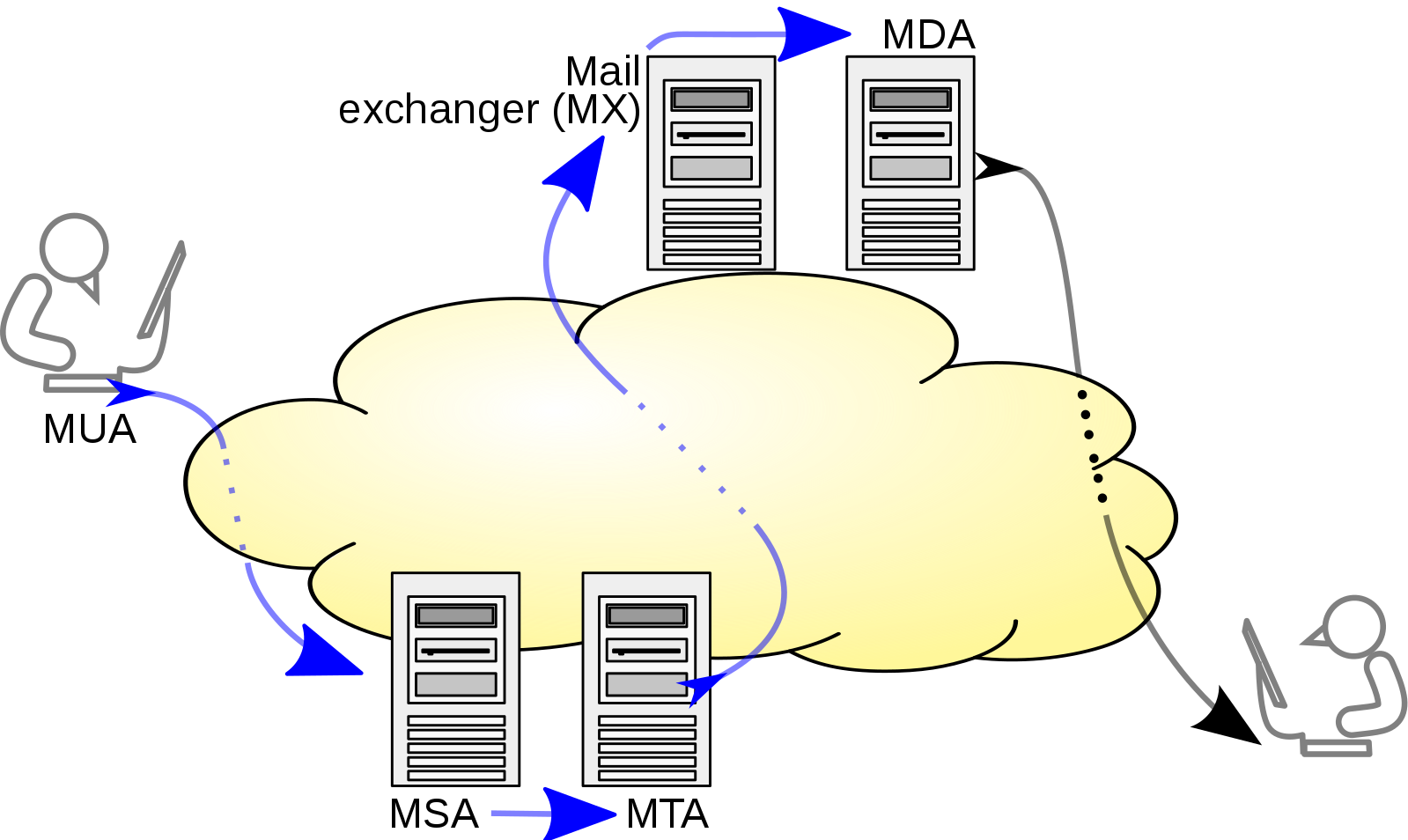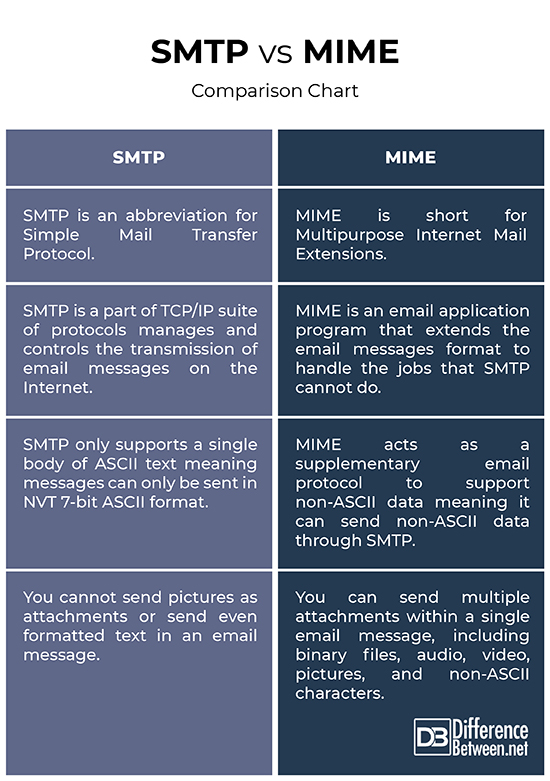Difference Between SMTP and MIME
We send emails almost every day but do you wonder how it works? Or what happens behind the scenes? SMTP is the de facto standard responsible for sending email messages from one server to another over TCP/IP based networks. SMTP is a simple mail transfer protocol that can only send text messages via the Internet and only in 7-bit ASCII format. While ASCII is great for writing simple memorandums and short messages, it is not capable enough to support other types of communication. So, to make the most out of email clients and to allow emails to carry more than just text messages, the MIME standard was developed to extend the functionality of SMTP and use characters sets other than ASCII. However, MIME cannot replace SMTP. Let’s take a good look at the two.

Simple Mail Transfer Protocol (SMTP)
SMTP, short for Simple Mail Transfer Protocol, is an application layer protocol for transmission of electronic mail on the internet. To most people, E-mail is just an application program that takes the message and magically delivers it to the recipient of their choosing. Most people do not have the slightest idea how the whole procedure behind the email flow works. SMTP is how it happens behind the scenes. SMTP is the very popular email protocol that allows two different users on two different servers to exchange textual data between each other. SMTP manages the transmission of email messages on the Internet. It is a part of TCP/IP suite of protocols that ensure smooth movement of electronics mails via the internet. The SMTP was first defined in RFC 788 and published in Nov 1981.

Multipurpose Internet Mail Extensions (MIME)
MIME is short for Multipurpose Internet Mail Extensions. MIME, as the name suggests, is an email application program that extends the email messages format to support more than just textual messages, such as audio, video, pictures, and so on. It was developed to overcome some serious limitations in SMTP. MIME augments the internet email protocol to enable transmission of non-ASCII data through emails, as opposed to SMTP which only transmission of text messages over the internet. In fact, MIME was developed mainly for SMTP, but the content types defined by MIME can also be used for communication protocols outside the email ecosystem, such as HTTP. In addition, MIME defines a mechanism that allows you to have multiple attachments into a single email message, including different file types. And the best part, MIME does not replace the RFCs 821/822; in fact, it is totally backward compatible with early implementations of SMTP protocol.
Difference between SMTP and MIME
Protocol
SMTP, short for Simple Mail Transfer Protocol, is a standard mail transfer protocol and a part of TCP/IP suite of protocols that allows two different users on two different servers to exchange textual data between each other. First defined in RFC 788 in Nov 1981, SMTP ensures the smooth flow of transmission of email messages on the Internet. MIME, abbreviated as Multipurpose Internet Mail Extensions, is an email application program that extends the email messages format to support more than just textual messages through email. However, MIME is not a mail protocol and cannot replace SMTP.
Format
SMTP is an application layer protocol that has been widely used as the de fact standard for email exchange since 1982. However, SMTP only supports a single body of ASCII text meaning messages can only be sent in NVT (Network Virtual Terminal) 7-bit ASCII format and messages over a certain size are not allowed. MIME augments the internet email protocol to enable transmission of non-ASCII data through emails, as opposed to SMTP. In fact, it acts as a supplementary email protocol to support non-ASCII data meaning it can send non-ASCII data through SMTP.
Attachments
SMTP is a simple email transfer protocol that allow for lines that contain no more than 1000 ASCII characters. With SMTP, you can only send text-based messages; you cannot send pictures as attachments or send even formatted text in an email message. MIME was developed to extend the functionality of SMTP; in fact, it was the limitations of SMTP that prompted the release of MIME. Using the MIME protocol, you can send multiple attachments within a single email message, including binary files, audio, video, pictures, and non-ASCII characters.
SMTP vs. MIME: Comparison Chart

Summary
SMTP has been the de fact standard for email exchange since 1982. But it is a simple mail transfer protocol which is not capable enough to send anything more than text messages or holding it in a queue. SMTP is like a mail carrier that picks up his daily quota of mails from the source and delivers them to the recipients. It does not care about where the mails are stored overnight or how it gets from point A to point B. MIME was developed to overcome the limitations of SMTP. MIME is a standard for encoding binary files, audio, video, pictures and non-ASCII characters within a mail. However, MIME is not a full-fledge mail protocol and it cannot replace SMTP; it only extends the functionality of SMTP to do everything SMTP can do and so much more.
- Difference Between Caucus and Primary - June 18, 2024
- Difference Between PPO and POS - May 30, 2024
- Difference Between RFID and NFC - May 28, 2024
Search DifferenceBetween.net :
Leave a Response
References :
[0]Image credit: https://commons.wikimedia.org/wiki/File:SMTP-transfer-model.svg
[1]Image credit: https://www.needpix.com/photo/618223/email-marketing-e-mail-money-dollar-people-clients-mail-device
[2]Rhoton, John. Programmer's Guide to Internet Mail: SMTP, POP, IMAP, and LDAP. Oxford, United Kingdom: Digital Press, 2000. Print
[3]Johnson, Dale. Inside Worry Free Business Security 8.0 Book. North Carolina, United States: Lulu Press, 2013. Print
[4]Kozierok, Charles M. The TCP/IP Guide: A Comprehensive, Illustrated Internet Protocols Reference. California, United States: No Starch Press, 2005. Print
[5]Redmond, Tony. Microsoft Exchange Server 2003. Amsterdam, Netherlands: Elsevier, 2003. Print
[6]Rhee, Man Young. Internet Security: Cryptographic Principles, Algorithms and Protocols. New Jersey, United States: John Wiley & Sons, 2003. Print
[7]Dean, Tamara. CompTIA Network+ 2009 In Depth. Massachusetts, United States: Cengage, 2014. Print
